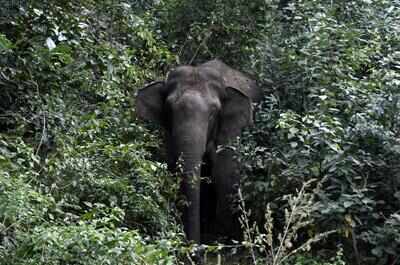
Despite being the state animal, elephants in Jharkhand are battling a crisis of harmonious coexistence with humans due to the failure of the state in drafting a dedicated habitat policy for the jumbos to strike a balance between infrastructural development and protection of wildlife. Unless the authorities wake up, soon, August 12 will be celebrated as World Elephant Day only symbolically.
Elephants have always been politically relevant for the state and it also the state animal. In the state’s first global business summit — Momentum Jharkhand — the logo was that of a flying elephant. Recently, chief minister Hemant Soren announced a change in the state logo and included motifs of elephants among others that depict the flora and fauna of the state. The new logo will officially be adopted on Independence Day.
Around 30% of the total area of the state is covered in forests, but elephants find very little space for themselves. This fact is evident from the last census carried out in 2017 which pegged their numbers at 555 against 688 in 2012. Though the forest department claims that currently the number has risen to anywhere between 600 and 650, an official census is yet to be carried out.
Issues such as fragmented corridors, lack of efficient and timely tracking mechanisms, degradation of resources inside notified green lungs among others are leading to further depletion in the number of elephants in the state. With humans encroaching forests, incidents of man-animal conflicts are also on the rise. In a decade, roughly 1,000 persons and around 100 elephants have died due to the conflicts and the number is still rising.
Other major reasons behind the dwindling number of jumbos in the state can also be attributed to both Maoists and anti-Maoist operations. While the rebels drive the animals out of the forests to make space for themselves, anti-Red operations hamper the ecosystem and the habitat of elephants.
Mining activities and laying of railway tracks on elephant corridors are also major reasons behind the fall in numbers.
Steps like the recent initiatives to stop and divert trains, including Rajdhani Express, passing through elephant corridors should be increased, opine experts.
As per the data of the Union ministry of environment, forests and climate change tabled in the Lok Sabha earlier this year, 230 human casualties were reported in Jharkhand in the last three fiscal years alone. During the same period, a total of six elephants died due to poaching, electrocution and in train accidents. This year alone, over 30 instances of man-elephant conflicts have been reported so far, including about half-a-dozen human casualties across the state.
Former state minister and an Independent MLA from Jamshedpur East, Saryu Rai, said the lack of habitat policy for elephants talks about the government’s misplaced priorities. Rai is known for his campaigns to safeguard wildlife and environment. Talking to TOI, he said, “I wrote to chief minister Hemant Soren a few days back since he holds the forest portfolio and pressed for a comprehensive policy for elephants.”
He added, “It’s an irony that even after 20 years since the formation of the state, which is known for its jal, jungle and jameen, we aren’t able to provide a safe abode to elephants, notified as our state animal.”
“There is an urgent need for an elephant-centric habitat policy. No government has ever worked towards this. While we are building roads, giving mining leases, encroaching upon forest land, no thought is spared for providing smooth passage to the animals,” he said.
Rai’s views are echoed by an elephant expert and former member of the state wildlife board, D S Srivastava. “Elephants are under immense stress today and gasping for a proper place to live, foods to eat and corridors for movements. They are now caught between the crossroads of development and human interventions into their territories. I have been fighting for a holistic elephant management plan — both long and short terms — but to no avail,” he said. Rai also stressed on the need for a dedicated rescue centre for elephants.
“Long-term plans should be focussed on the rejuvenation of their habitats while short-term plans will address day-to-day challenges. Piecemeal approaches by the forest department are only adding to the woes faced by the elephants,” he added, citing how the established elephant corridors in Singhbhum connecting Odisha or between Dalma and West Bengal have got fragmented over the years.
Notably, the state forest department in 2009-10 had proposed a state-level rescue centre in the Dalma Elephant Sanctuary, but the proposal could not take shape due to bureaucratic hassles. “Today, there is no facility in our state to treat injured elephants,” Srivastava noted.
Jharkhand’s principal chief conservator of forests P K Verma conceded that here is no dedicated habitat policy in place so far, but said that the department has been working round-the-year for forest and wildlife management.
Citing a host of initiatives to prevent conflicts, Verma said, “We have set up dedicated quick response teams to tackle man-elephant conflicts. We are in the process of equipping them with more manpower and resources soon, if all goes well. We are also planning to prepare teams from a joint forest management committee at village levels through training to raise a local army of elephant task force who can be aware and tackle issues when elephants venture into human habitation areas.”
Verma, however, stressed on the need for early tracking of elephant movement to allow them easy access to their desired destinations. “While we have started a GPS-based elephant monitoring system, which needs to be strengthened.”
Elephants have always been politically relevant for the state and it also the state animal. In the state’s first global business summit — Momentum Jharkhand — the logo was that of a flying elephant. Recently, chief minister Hemant Soren announced a change in the state logo and included motifs of elephants among others that depict the flora and fauna of the state. The new logo will officially be adopted on Independence Day.
Around 30% of the total area of the state is covered in forests, but elephants find very little space for themselves. This fact is evident from the last census carried out in 2017 which pegged their numbers at 555 against 688 in 2012. Though the forest department claims that currently the number has risen to anywhere between 600 and 650, an official census is yet to be carried out.
Issues such as fragmented corridors, lack of efficient and timely tracking mechanisms, degradation of resources inside notified green lungs among others are leading to further depletion in the number of elephants in the state. With humans encroaching forests, incidents of man-animal conflicts are also on the rise. In a decade, roughly 1,000 persons and around 100 elephants have died due to the conflicts and the number is still rising.
Other major reasons behind the dwindling number of jumbos in the state can also be attributed to both Maoists and anti-Maoist operations. While the rebels drive the animals out of the forests to make space for themselves, anti-Red operations hamper the ecosystem and the habitat of elephants.
Mining activities and laying of railway tracks on elephant corridors are also major reasons behind the fall in numbers.
Steps like the recent initiatives to stop and divert trains, including Rajdhani Express, passing through elephant corridors should be increased, opine experts.
As per the data of the Union ministry of environment, forests and climate change tabled in the Lok Sabha earlier this year, 230 human casualties were reported in Jharkhand in the last three fiscal years alone. During the same period, a total of six elephants died due to poaching, electrocution and in train accidents. This year alone, over 30 instances of man-elephant conflicts have been reported so far, including about half-a-dozen human casualties across the state.
Former state minister and an Independent MLA from Jamshedpur East, Saryu Rai, said the lack of habitat policy for elephants talks about the government’s misplaced priorities. Rai is known for his campaigns to safeguard wildlife and environment. Talking to TOI, he said, “I wrote to chief minister Hemant Soren a few days back since he holds the forest portfolio and pressed for a comprehensive policy for elephants.”
He added, “It’s an irony that even after 20 years since the formation of the state, which is known for its jal, jungle and jameen, we aren’t able to provide a safe abode to elephants, notified as our state animal.”
“There is an urgent need for an elephant-centric habitat policy. No government has ever worked towards this. While we are building roads, giving mining leases, encroaching upon forest land, no thought is spared for providing smooth passage to the animals,” he said.
Rai’s views are echoed by an elephant expert and former member of the state wildlife board, D S Srivastava. “Elephants are under immense stress today and gasping for a proper place to live, foods to eat and corridors for movements. They are now caught between the crossroads of development and human interventions into their territories. I have been fighting for a holistic elephant management plan — both long and short terms — but to no avail,” he said. Rai also stressed on the need for a dedicated rescue centre for elephants.
“Long-term plans should be focussed on the rejuvenation of their habitats while short-term plans will address day-to-day challenges. Piecemeal approaches by the forest department are only adding to the woes faced by the elephants,” he added, citing how the established elephant corridors in Singhbhum connecting Odisha or between Dalma and West Bengal have got fragmented over the years.
Notably, the state forest department in 2009-10 had proposed a state-level rescue centre in the Dalma Elephant Sanctuary, but the proposal could not take shape due to bureaucratic hassles. “Today, there is no facility in our state to treat injured elephants,” Srivastava noted.
Jharkhand’s principal chief conservator of forests P K Verma conceded that here is no dedicated habitat policy in place so far, but said that the department has been working round-the-year for forest and wildlife management.
Citing a host of initiatives to prevent conflicts, Verma said, “We have set up dedicated quick response teams to tackle man-elephant conflicts. We are in the process of equipping them with more manpower and resources soon, if all goes well. We are also planning to prepare teams from a joint forest management committee at village levels through training to raise a local army of elephant task force who can be aware and tackle issues when elephants venture into human habitation areas.”
Verma, however, stressed on the need for early tracking of elephant movement to allow them easy access to their desired destinations. “While we have started a GPS-based elephant monitoring system, which needs to be strengthened.”

Coronavirus outbreak
Trending Topics
LATEST VIDEOS
City
 On cam: 12-year-old risks life to save drowning man twice his age in Nainital
On cam: 12-year-old risks life to save drowning man twice his age in Nainital  Shocking: UP BJP leader shot dead during morning walk in Baghpat
Shocking: UP BJP leader shot dead during morning walk in Baghpat  Shocking: 33-year-old man dials 100, issues threat for PM Narendra Modi, arrested by Noida police
Shocking: 33-year-old man dials 100, issues threat for PM Narendra Modi, arrested by Noida police  Peace and brotherhood will remain in Congress party: Rajasthan CM Ashok Gehlot
Peace and brotherhood will remain in Congress party: Rajasthan CM Ashok Gehlot
More from TOI
Navbharat Times
Featured Today in Travel
Quick Links
Kerala Coronavirus Helpline NumberHaryana Coronavirus Helpline NumberUP Coronavirus Helpline NumberBareilly NewsBhopal NewsCoronavirus in DelhiCoronavirus in HyderabadCoronavirus in IndiaCoronavirus symptomsCoronavirusRajasthan Coronavirus Helpline NumberAditya ThackerayShiv SenaFire in MumbaiAP Coronavirus Helpline NumberArvind KejriwalJammu Kashmir Coronavirus Helpline NumberSrinagar encounter
Get the app



